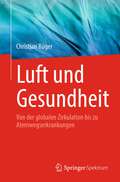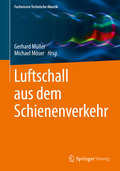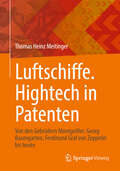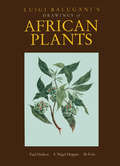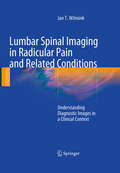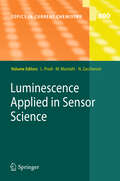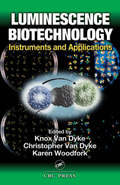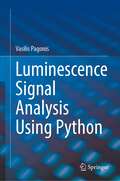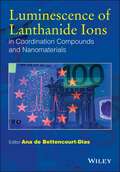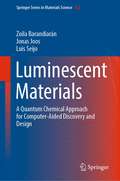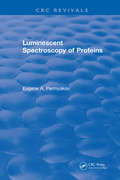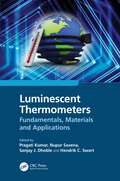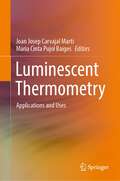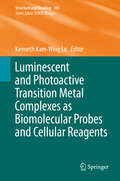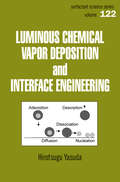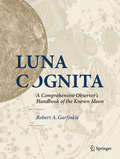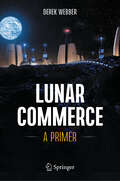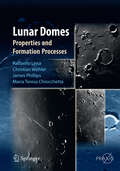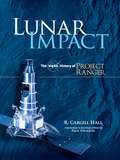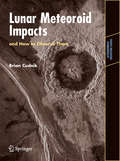- Table View
- List View
Luft und Gesundheit: Von der globalen Zirkulation bis zu Atemwegserkrankungen
by Christian RügerIst frische Luft ein Mythos? In diesem Werk durchstreift der Autor die Lebensräume des Menschen und bietet Einblicke in die jeweils anzutreffenden Luftqualitäten. Aerosole steigen nicht von allein in die Luft auf. Die Partikel lösen sich aus dem festen oder flüssigen Verband. In der Luft kommen alle flugfähigen Masseteilchen miteinander in Kontakt – als ein anschauliches Beispiel dient dem Leser die Entstehung von Wassertropfen. Jede Luftschicht der Atmosphäre wirkt unterschiedlich auf die Atemluft ein und der Wind spielt dabei seine ganz eigene Rolle. Einerseits ist er Verteiler von Schadstoffen, und andererseits Garant frischer Luft am Erdboden. Die Verschmutzung der Luft ruft den Gesetzgeber auf den Plan. Wir erleben derzeit eine rasante Entwicklung von der Aufhebung der Zünfte bis zur Klimadiskussion.Große Relevanz für die Gesundheit besitzt die Schnittstelle zwischen Luft und Mensch: die Atemwege. Deren Schleimhäute stehen im Zentrum unserer Immunabwehr, und müssen einen „Etagenwechsel“ von Infektionen der oberen Atemwege in untere Lungenabschnitte verhindern. Diese und viele weitere spannende Zusammenhänge und Themen im breiten Spektrum zwischen Meteorologie und Atemwegserkrankungen werden anschaulich, gut zugänglich und anhand praktischer Beispiele abgehandelt, um sich eine sichere Plattform zur Beurteilung der Flut von Umweltnachrichten zu schaffen.
Luftschall aus dem Schienenverkehr (Fachwissen Technische Akustik)
by Michael Möser Gerhard MüllerDieser Band der Reihe Fachwissen Technische Akustik gibt einen Überblick über bahnakustische Fragestellungen und beschreibt dabei die wichtigsten Mechanismen, Minderungsmaßnahmen, Mess- und Simulationsverfahren und zeigt typische Mess- und Berechnungsergebnisse. Daneben werden Prognoseverfahren beschrieben und es wird auf die Bewertung von Schienenverkehrslärm eingegangen.
Luftschiffe. Hightech in Patenten: Von den Gebrüdern Montgolfier, Georg Baumgarten, Ferdinand Graf von Zeppelin bis heute
by Thomas Heinz MeitingerAls Luftschiffe kennt man die Zeppeline. Aber die Zeppeline waren nur der Endpunkt einer technischen Entwicklung von Fahrzeugen der Lüfte, die zu Ihrer Zeit zum absoluten Hightech gehörten. In diesem Buch wird dem Leser anhand der Patentanmeldetätigkeit der Pioniere der Luftschifffahrt ein plastisches Bild vermittelt, wie sich das Ringen um die technologische Entwicklung der Luftschifffahrt in der Praxis darstellte. Das Unglück des Zeppelins „Hindenburg“ 1937 in Lakehurst, New York, kennzeichnet das jähe Ende der beispiellosen Erfolgsgeschichte der Luftschiffe.
Luigi Balugani's Drawings of African Plants
by Paul HultonThis work outlines the life of James Bruce of Kinnard, and Luigi Balugani and his relationship with James Bruce.
Lukezilla Beats the Game
by Kurtis ScalettaIn real life, Lucas is small and unathletic. But as Trunkzilla in the online game Smashtown Frenzy, he's the biggest, toughest fighter on the streets. No wonder he prefers games to real life! He plans to spend all summer battling his way through the Smashtown tournament with his team, but his parents have other plans for him: volunteer work. Lucas signs up to be a Senior Sitter and gets matched with a cool old librarian named Isaac who likes cats and detective novels. Mornings with Isaac and afternoons gaming are working out great until Lucas's Smashtown success hits a speed bump and Isaac's health takes a tragic turn. Lucas saves Isaac's life but then finds himself burdened with a new sense of moral responsibility that gets him thrown off his team, banned from Smashtown, and made into a meme for internet haters. Some reward for being a hero! Lucas has one last shot to prevail, win back his friends, and show his parents how much gaming means to him.
Lumbar Spinal Imaging in Radicular Pain and Related Conditions
by J. T. WilminkA general consensus exists,that lumbosacral nerve root compression is the primary cause of sciatica and neurogenic claudication, although humoral and vascular factors certainly play a role as well. This book focuses on imaging the various ways in which nerve root compression can come about, and determining which anatomic features are reliably associated with the production of radicular pain. After a discussion of the nature of radicular pain and related symptoms, spinal imaging techniques and options are reviewed, with emphasis on the role of MR myelography in assessing the intradural nerve roots. A chapter on normal topographic, sectional, and functional radiologic anatomy is followed by presentations on pathologic anatomy, addressing mechanisms of nerve root compression, and on pre- and postoperative imaging. Features relevant to prediction of the natural history are discussed, and a section is devoted to the performance and reporting of a spinal imaging study.
Luminescence Applied in Sensor Science
by Luca Prodi Nelsi Zaccheroni Marco MontaltiMolecular Logic Gates and Luminescent Sensors Based on Photoinduced Electron Transfer, by A. Prasanna de Silva and S. Uchiyama; Luminescent Chemical Sensing, Biosensing, and Screening Using Upconverting Nanoparticles, by D. E. Achatz, R. Ali, and O. S. Wolfbeis; Luminescence Amplification Strategies Integrated with Microparticle and Nanoparticle Platforms, by S. Zhu, T. Fischer, W. Wan, A. B. Descalzo, and K. Rurack; Luminescent Chemosensors Based on Silica Nanoparticles, by S. Bonacchi, D. Genovese, R. Juris, M. Montalti, L. Prodi, E. Rampazzo, M. Sgarzi, and N. Zaccheroni; Fluorescence Based Sensor Arrays, by R. Paolesse, D. Monti, F. Dini, and C. Di Natale; Enantioselective Sensing by Luminescence, by A. Accetta, R. Corradini, and R. Marchelli
Luminescence Biotechnology: Instruments and Applications
by Knox Van Dyke Christopher Van Dyke Karen WoodforkThe dangers and drawbacks inherent in radioactivity-based methods along with a demonstrated and dramatic increase in sensitivity have precipitated a major shift towards luminescence measurements and visualization techniques. Their use has now spread even to traditional clinical environments, and their applications have grown from clinical assays to
Luminescence Signal Analysis Using Python
by Vasilis PagonisThis book compiles and presents a complete package of open-access Python software code for luminescence signal analysis in the areas of radiation dosimetry, luminescence dosimetry, and luminescence dating. Featuring more than 90 detailed worked examples of Python code, fully integrated into the text, 16 chapters summarize the theory and equations behind the subject matter, while presenting the practical Python codes used to analyze experimental data and extract the various parameters that mathematically describe the luminescence signals. Several examples are provided of how researchers can use and modify the available codes for different practical situations. Types of luminescence signals analyzed in the book are thermoluminescence (TL), isothermal luminescence (ITL), optically stimulated luminescence (OSL), infrared stimulated luminescence (IRSL), timeresolved luminescence (TR) and dose response of dosimetric materials. The open-access Python codes are available at GitHub.The book is well suited to the broader scientific audience using the tools of luminescence dosimetry: physicists, geologists, archaeologists, solid-state physicists, medical physicists, and all scientists using luminescence dosimetry in their research. The detailed code provided allows both students and researchers to be trained quickly and efficiently on the practical aspects of their work, while also providing an overview of the theory behind the analytical equations.
Luminescence in Electrochemistry
by Fabien Miomandre Pierre AudebertThis book highlights the various topics in which luminescence and electrochemistry are intimately coupled. The topic of this book is clearly at the frontier between several scientific domains involving physics, chemistry and biology. Applications in these various fields naturally also need to be mentioned, especially concerning displays and advanced investigation techniques in analytical chemistry or for biomedical issues.
Luminescence of Lanthanide Ions in Coordination Compounds and Nanomaterials
by Ana de Bettencourt-DiasThis comprehensive book presents the theoretical principles, current applications and latest research developments in the field of luminescent lanthanide complexes; a rapidly developing area of research which is attracting increasing interest amongst the scientific community.Luminescence of Lanthanide Ions in Coordination Compounds and Nanomaterials begins with an introduction to the basic theoretical and practical aspects of lanthanide ion luminescence, and the spectroscopic techniques used to evaluate the efficiency of luminescence. Subsequent chapters introduce a variety of different applications including:* Circularly polarized luminescence* Luminescence bioimaging with lanthanide complexes * Two-photon absorption of lanthanide complexes * Chemosensors* Upconversion luminescence* Excitation spectroscopy* Heterometallic complexes containing lanthanidesEach chapter presents a detailed introduction to the application, followed by a description of experimental techniques specific to the area and an extensive review of recent literature.This book is a valuable introduction to the literature for scientists new to the field, as well as providing the more experienced researcher with a comprehensive resource covering the most relevant information in the field; a 'one stop shop' for all key references.
Luminescent Materials: A Quantum Chemical Approach for Computer-Aided Discovery and Design (Springer Series in Materials Science #322)
by Zoila Barandiarán Jonas Joos Luis SeijoThis book describes a unique combination of quantum chemical methods for calculating the basic physical properties of luminescent materials, or phosphors. These solid inorganic materials containing an optically active dopant are key players in several major fields of societal interest, including energy-efficient lighting, solar cells, and medical imaging. The novel ab initio methods described in this book are especially designed to target the crowded and complex electronic excited states of lanthanide activators in inorganic solids. The book is well suited to both new and experienced researchers alike and appeals to a broad range of theoretical and experimental backgrounds. The material presented enables an adept understanding of elaborate calculations, which, in tandem with experiments, give essential insight into difficult luminescence problems and quandaries, thus fully preparing the reader for an educated search for new functional luminescent materials
Luminescent Spectroscopy of Proteins
by Eugene A. PermyakovLuminescent Spectroscopy of Proteins is devoted to the method of intrinsic protein luminescence, one of the most popular experimental methods in modern biophysics and biochemistry. The book discusses general physical principles of the luminescence method; spectral properties of the main protein chromophores; and protein luminescence and its use for studies on structural, physico-chemical, and functional properties of proteins. Principles of luminescent spectroscopy are illustrated by real-life applications and problems. Luminescent Spectroscopy of Proteins will be an excellent reference for biophysicists, biochemists, analytical chemists, and other scientists interested in this topic.
Luminescent Thermometers: Fundamentals, Materials and Applications
by Hendrik C. Swart Sanjay J. Dhoble Pragati Kumar Nupur SaxenaLuminescent Thermometers deals with all aspects of the subject from principles of methods to their applications in different areas. This book familiarizes the readers with the fundamentals of luminescence thermometry, materials used for the development of different luminescence thermometers, viz. metal-organic frameworks (MOFs) including lanthanide-doped MOFs referred as LOFs, quantum dots (QDs), rare earth-doped phosphors, and upconversion phosphors. Further, some advanced and next generation approaches for luminescent thermometers such as carbon-based materials, nanocomposites, double perovskites and garnet systems are assimilated. The applications of luminescent thermometers in temperature sensing of biological cells and tumors, thermal imaging of biological cells, flexible temperature sensors, health monitoring with wearable thermometers, and environmental monitoring are the key features of this volume. It is a valuable contribution to the literature for material scientists and engineers in academia and R&D as well as researchers working in biology and environment science.Key Features: Covers entire range of luminescent thermometers from fundamentals to applications Describes state-of-the-art of materials and next generation approaches for luminescence-based nanothermometery Discusses the high-end utilities of luminescent thermometers in different aspects of human life are discussed
Luminescent Thermometry: Applications and Uses
by Joan Josep Carvajal Martí Maria Cinta Pujol BaigesThis book is a detailed, state-of-the-art account of the applications and uses of luminescence thermometry. It covers a wide range of fields, including biomedicine, biology, and catalysis. The book also explains the luminescence thermometric parameters used to sense temperature via luminescence with different materials, analyzing the different strategies used to improve thermal sensitivity and temperature resolution.The readers of this book are any researcher interested in the field, because of its topical coverage, as well as bachelor and graduate students, as an introduction to this novel field. The book ends with a general critical analysis of the results presented, where the editors discuss about the challenges and opportunities in the development of these highly sensitive new class of thermometers.
Luminescent and Photoactive Transition Metal Complexes as Biomolecular Probes and Cellular Reagents
by Kenneth Kam-Wing LoThe series Structure and Bonding publishes critical reviews on topics of research concerned with chemical structure and bonding. The scope of the series spans the entire Periodic Table and addresses structure and bonding issues associated with all of the elements. It also focuses attention on new and developing areas of modern structural and theoretical chemistry such as nanostructures, molecular electronics, designed molecular solids, surfaces, metal clusters and supramolecular structures. Physical and spectroscopic techniques used to determine, examine and model structures fall within the purview of Structure and Bonding to the extent that the focus is on the scientific results obtained and not on specialist information concerning the techniques themselves. Issues associated with the development of bonding models and generalizations that illuminate the reactivity pathways and rates of chemical processes are also relevant. The individual volumes in the series are thematic. The goal of each volume is to give the reader, whether at a university or in industry, a comprehensive overview of an area where new insights are emerging that are of interest to a larger scientific audience. Thus each review within the volume critically surveys one aspect of that topic and places it within the context of the volume as a whole. The most significant developments of the last 5 to 10 years should be presented using selected examples to illustrate the principles discussed. A description of the physical basis of the experimental techniques that have been used to provide the primary data may also be appropriate, if it has not been covered in detail elsewhere. The coverage need not be exhaustive in data, but should rather be conceptual, concentrating on the new principles being developed that will allow the reader, who is not a specialist in the area covered, to understand the data presented. Discussion of possible future research directions in the area is welcomed. Review articles for the individual volumes are invited by the volume editors. Readership: research scientists at universities or in industry, graduate students Special offer For all customers who have a standing order to the print version of Structure and Bonding, we offer free access to the electronic volumes of the Series published in the current year via SpringerLink.
Luminosity Measurement at the Compact Muon Solenoid Experiment of the LHC (Springer Theses)
by Olena KarachebanThis book describes the application of a novel technology for beam instrumentation and luminosity measurement and first results on a cutting edge technology potentially to be used after the upgrade of the Large Hadron Collider to higher luminosity.It presents a unique diamond-based luminometer with a detailed performance study.The online bunch-by-bunch luminosity measurements provide an invaluable feedback to the Collider for beam optimisation and for the understanding of beam dynamics.The precision of the luminosity measurement is crucial for all physics analyses. This book highlights the Van der Meer method, which is used for the calibration of the luminometers of the CMS (Compact Muon Solenoid) experiment, and describes the estimate of systematic uncertainties, e.g. due to radiation damage of sensors and electronics and uncertainties of beam parameters.For the future high-luminosity upgrade of the collider, sapphire sensors are investigated in a test beam. It is demonstrated for the first time that sapphire sensors can be used as single particle detectors. A model for the charge transport in sapphire is developed and successfully applied.
Luminous Chemical Vapor Deposition and Interface Engineering (Surfactant Science)
by Hirotsugu YasudaProviding in-depth coverage of the technologies and various approaches, Luminous Chemical Vapor Deposition and Interface Engineering showcases the development and utilization of LCVD procedures in industrial scale applications. It offers a wide range of examples, case studies, and recommendations for clear understanding of this innovative science.
Luna Cognita: A Comprehensive Observer’s Handbook of the Known Moon
by Robert A. GarfinkleThis comprehensive three-volume set takes you on an incomparable journey of our closest celestial neighbor. Not since the golden age of 19th-century lunar guidebooks has one author managed to cover the Moon in such detail as this all-in-one handbook. The handbook begins with a section on the Moon’s place in human history, mythology and lore, before gravitating closer to the Moon itself through scientific sections on the Earth-Moon system, lunar motions and cycles. Following these are technical chapters on how to purchase, use and care for lunar observing and photography equipment. Techniques for observing the Moon (both with the naked eye and optical instruments) are detailed as the reader approaches the Moon’s surface on this visual tour-de-force. A close-up exploration of the Moon is the result. The “crater-hop” chapters discuss the physical aspects of the Moon’s features, offering brief biographical information on the person for whom the feature is named, as well as how each individual was involved in the development of science and selenography from ancient to modern times. Luna Cognita goes far beyond any recent work in both breadth and depth of coverage on the Moon. Written in an accessible, engaging manner for readers of all backgrounds and levels of expertise, this handbook is thus an invaluable resource for anybody who looks up at the glowing sphere in the night sky and wants to learn more about the “Known Moon.”
Lunar Commerce: A Primer
by Derek WebberThis book explores the advent of lunar commerce including the potential scale and timing of the initiative, the associated revenue potential and the potential risks and uncertainties. Specifically, it discusses the reason for the increased interest in lunar commerce, which lunar markets will be part of the initiative and how much of it will be commercial or dependent on government funding. It provides an easy introduction to the content of the Lunar Commerce Portfolio, which was recently issued, under the author's leadership, by the Working Group on Lunar Commerce and Economics of the Moon Village Association, which has Observer Status at the United Nations in Vienna.
Lunar Domes: Properties and Formation Processes
by Christian Wöhler Jim Phillips Maria Teresa Chiocchetta Raffaello LenaLunar domes are structures of volcanic origin which are usually difficult to observe due to their low heights. The Lunar Domes Handbook is a reference work on these elusive features. It provides a collection of images for a large number of lunar domes, including telescopic images acquired with advanced but still moderately intricate amateur equipment as well as recent orbital spacecraft images. Different methods for determining the morphometric properties of lunar domes (diameter, height, flank slope, edifice volume) from image data or orbital topographic data are discussed. Additionally, multispectral and hyperspectral image data are examined, providing insights into the composition of the dome material. Several classification schemes for lunar domes are described, including an approach based on the determined morphometric quantities and spectral analyses. Furthermore, the book provides a description of geophysical models of lunar domes, which yield information about the properties of the lava from which they formed and the depth of the magma source regions below the lunar surface.
Lunar Impact: The NASA History of Project Ranger (Dover Books on Astronomy)
by Paul Dickson R. Cargill HallAmerica's first successful attempt at unmanned lunar exploration, Project Ranger culminated in close-up television images of the moon's surface. Sponsored by NASA and executed by the Jet Propulsion Lab, the project ran from 1959 to 1965 and produced management techniques, flight operating procedures, and technology employed by later space missions.This official NASA publication presents the complete history of the nine Project Ranger missions. Author R. Cargill Hall, the historian of the Jet Propulsion Laboratory, offers an authoritative account of the evolution and operations of the continuing program of unmanned exploration of deep space. More than 100 photographs depict key personnel and illustrate rockets and a range of other equipment. Nine helpful appendixes feature a fascinating array of source documents.
Lunar Meteoroid Impacts and How to Observe Them
by Brian CudnikThe face of the Moon we see today has been substantially etched by the effects of meteor impacts. Craters on the Moon are the result of ancient impacts with large meteorites - or small asteroid-like bodies - which produced both primary craters (where the meteorites hit) and secondary craters (where material hurled high above the surface crashed back down). Even some of the vast lunar "seas" - actually basalt plains from ancient volcanic eruptions - may have been the result of impacts that triggered lava outflows. The era of major impacts on the Moon may have passed, but lunar meteorites may well be the cause of what are known as Lunar Transient Phonomena ("LTP" or sometimes "TLP") flashes and puffs of gas or vaporized rock or dust that are observed on the Moon's surface. This book looks at the way the Moon has been shaped by meteorites, proposes lunar meteorites as the most likely cause of most LTPs and describes in practical detail how amateur astronomers can observe impacts on the Moon, past and current.
Lunar Outfitters: Making the Apollo Space Suit
by Bill AyreyThe design processes behind a giant leap for mankind Neil Armstrong in a space suit on the moon remains an iconic representation of America’s technological ingenuity. Few know that the Model A-7L pressure suit worn by the Apollo 11 astronauts, and the Model A-7LB that replaced it in 1971, originated at ILC Industries (now ILC Dover, LP), an obscure Delaware industrial firm.Longtime ILC space suit test engineer Bill Ayrey draws on original files and photographs to tell the dramatic story of the company’s role in the Apollo Program. Though respected for its early designs, ILC failed to win NASA’s faith. When the government called for new suit concepts in 1965, ILC had to plead for consideration before NASA gave it a mere six weeks to come up with a radically different design. ILC not only met the deadline but won the contract. That underdog success led to its greatest challenge: winning a race against time to create a suit that would determine the success or failure of the Apollo missions—and life or death for the astronauts. A fascinating behind-the-scenes history of a vital component of the space program, Lunar Outfitters goes inside the suit that made it possible for human beings to set foot on the moon.
Lunar and Interplanetary Trajectories
by Robin BiesbroekThisbook provides readers with a clear description of the types of lunar andinterplanetary trajectories, and how they influence satellite-system design. The description follows an engineering rather than a mathematical approach andincludes many examples of lunar trajectories, based on real missions. It helpsreaders gain an understanding of the driving subsystems of interplanetary andlunar satellites. The tables and graphs showing features of trajectories makethe book easy to understand.
